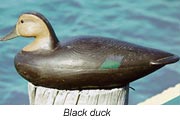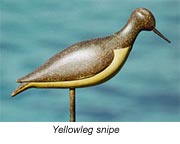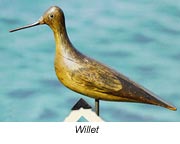by Joe French
 While looking at some dusty decoys in Bill Mackey's basement in 1954, Bill mentioned that Walter Bush, who had been a friend of his and Joel Barber, had died. An early enthusiast, Bush had amassed a great collection of decoys, and honoring his request, his wife had donated them to the Staten Island Historical Society Museum after his death. Naturally, the next step for me was to get myself to the museum. While looking at some dusty decoys in Bill Mackey's basement in 1954, Bill mentioned that Walter Bush, who had been a friend of his and Joel Barber, had died. An early enthusiast, Bush had amassed a great collection of decoys, and honoring his request, his wife had donated them to the Staten Island Historical Society Museum after his death. Naturally, the next step for me was to get myself to the museum.
On arrival, we were directed to two rooms where the decoy display was being completed. The larger of the two rooms was surrounded with shelves filled with some great looking decoys. The shelves in the second room were only partially full, but bushel baskets and boxes of decoys were still waiting for a home. The exceptionally nice man, a successful businessman and volunteer officer of the museum, told us they had more decoys than they could use.
 Undoubtedly, I had passed up many opportunities in my life, but not this one. I called Mrs. Bush, and soon thereafter, my wife, Arleen, and I were ushered into what seemed to be the spacious penthouse of the hotel. Mrs. Bush, a delightful person, took an immediate shine to Arlene, and I've always felt that made it easier for me to obtain the leftover decoys. Before we left, she agreed to sell me any decoys the museum didn't use. She then called the head of the museum instructing him to allow me to have anything that wouldn't be going on display. She also told me that Bill Mackey had appraised the collection for her and asked me not to tell him of our transaction. Of course I agreed, and never did tell Bill, but it did cause me a few uncomfortable moments for a number of years. Undoubtedly, I had passed up many opportunities in my life, but not this one. I called Mrs. Bush, and soon thereafter, my wife, Arleen, and I were ushered into what seemed to be the spacious penthouse of the hotel. Mrs. Bush, a delightful person, took an immediate shine to Arlene, and I've always felt that made it easier for me to obtain the leftover decoys. Before we left, she agreed to sell me any decoys the museum didn't use. She then called the head of the museum instructing him to allow me to have anything that wouldn't be going on display. She also told me that Bill Mackey had appraised the collection for her and asked me not to tell him of our transaction. Of course I agreed, and never did tell Bill, but it did cause me a few uncomfortable moments for a number of years.
After we left Mrs. Bush, we wasted no time in getting to the museum, which was closed, but the director was expecting us and showed us where the excess decoys were. I noticed there were a number of shorebirds that were not on the shelves, so I asked the director, "What about the shorebirds?" Evidently they weren't too interested in shorebirds because he told me to take what I wanted, but to leave them some. I did exactly as he requested. But I'm afraid if I knew than what I know now, I wouldn't have been as generous with what I left.
 I never told Bill that I bought any of the Bush collection decoys. As a result, whenever he visited (he was a sales manager for Minwax), I was forced to scamper around the house and hide all the ducks and shorebirds. Bill would have recognized them in an instant. I kept the secret for a long time, as he still didn't know I had acquired the decoys when he published his book in 1965 it indicated that my Dilley was still in Staten Island. But not long afterwards Mackey had discovered the sale from someone at the museum. In a conversation with Mrs. Bush, she told me that Bill was mad at her because I got the birds. I never told Bill that I bought any of the Bush collection decoys. As a result, whenever he visited (he was a sales manager for Minwax), I was forced to scamper around the house and hide all the ducks and shorebirds. Bill would have recognized them in an instant. I kept the secret for a long time, as he still didn't know I had acquired the decoys when he published his book in 1965 it indicated that my Dilley was still in Staten Island. But not long afterwards Mackey had discovered the sale from someone at the museum. In a conversation with Mrs. Bush, she told me that Bill was mad at her because I got the birds.
Along with a Shourds robin snipe and a curlew by Stiles, and the above mentioned Dilley plover, I chose three shorebirds that were marked "Greene Collection," along with the name of the species, on the bottom of their wooden stands. They included a willet, a black-bellied plover and a yellowleg snipe, all three hollow-carved with removable mortised necks and heads that inlet into the body. The willet and black-bellied plover is definitely made by the same maker. The painting is simple and effective, and if you look closely, you can notice that the carver left knife marks on the body, even though the head and flat part of the tail are sanded smooth. Though one observer said he thought the carver didn't bother to finish it, I am sure after the tremendous detailed labor he had done, he felt this added to the beauty of the carving. I can picture him holding the bird at arm's length and admiring the lines. Unfortunately, the carver is still unknown after all these years, and all efforts to even find where they came from have been unsuccessful. There were a few others by this maker in the Bush collection that I didn't take, including a dowitcher identical to the group in the Shelburne Museum collection. I've never felt that the dowitchers are as attractive as the other species in the group.
 Bud Ward sold some of the shorebirds from the museum to a collector I'll call Arthur, although that's not his name. Some time later Arthur sold two of these shorebirds to Jim McCleery. Although Arthur knew nothing of it at the time, these were two of the unknown dovetailed shorebirds from Walter Bush's "Greene Collection." McCleery also tried to identify the maker of these decoys, but to no avail. At a Sotheby's auction in 1979, he bought a hollow Canada goose with a removable head that was dovetailed into the body and had the same distinctive knife marks found on the body of the shorebirds. We agreed that it had to have been made by the same carver. In January 2000 it was back at Sotheby's, lot number 437 in the McCleery auction that was sold in association with Guyette & Schmidt. Bud Ward sold some of the shorebirds from the museum to a collector I'll call Arthur, although that's not his name. Some time later Arthur sold two of these shorebirds to Jim McCleery. Although Arthur knew nothing of it at the time, these were two of the unknown dovetailed shorebirds from Walter Bush's "Greene Collection." McCleery also tried to identify the maker of these decoys, but to no avail. At a Sotheby's auction in 1979, he bought a hollow Canada goose with a removable head that was dovetailed into the body and had the same distinctive knife marks found on the body of the shorebirds. We agreed that it had to have been made by the same carver. In January 2000 it was back at Sotheby's, lot number 437 in the McCleery auction that was sold in association with Guyette & Schmidt.
The two "Greene Collection" shorebirds, of course, were in the same auction. Lot number 550, a beautiful bird, was listed as "species unknown, possibly short-billed dowitcher, maker unknown, probably Massachusetts last quarter 19th century." Jim never knew what the species was and neither did they. The other shorebird, lot 552, was listed as a dowitcher or possibly lesser yellowlegs. The Canada goose cost the successful bidder $233,500. Lot 552, despite the somewhat unattractive head, sold for an unbelievable price of $48,875 and the gorgeous "species unknown," lot 550, brought $29,900. And guess who bought lot 550 - Arthur! It's nice to bring old friends home.
For the complete story, please see the May/June 2001 issue of Decoy Magazine.
Tidbits Main Index

|


